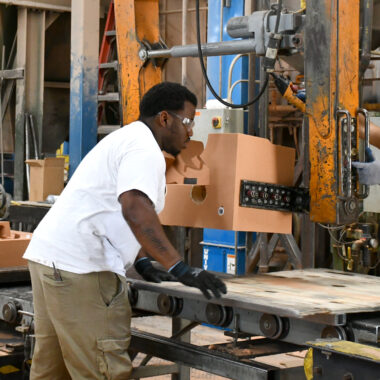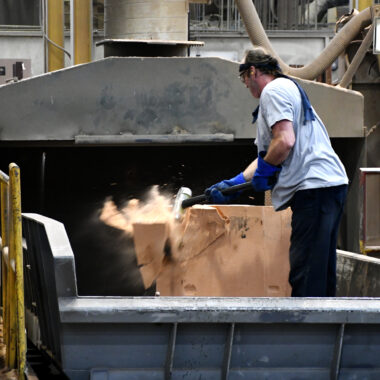The Top Techniques for Light Weight Aluminum Spreading That You Required to Know
From the standard sand spreading method to the elaborate investment spreading process, each method offers unique advantages that cater to different project needs. As we navigate through the leading techniques for light weight aluminum spreading, it becomes apparent that grasping these approaches is vital for attaining optimum outcomes.
Sand Spreading Strategy
The Sand Casting Method is a basic approach in aluminum spreading, widely utilized for its cost-effectiveness and convenience in producing detailed steel forms. This strategy entails developing a mold and mildew made from compacted sand right into which liquified light weight aluminum is poured, enabling it to strengthen and take the form of the mold and mildew. One of the vital advantages of sand spreading is its capacity to create intricate geometries with reasonably low tooling prices, making it an appealing choice for makers seeking to produce distinct elements.
In the sand casting procedure, a pattern of the last component is pressed right into a fine sand mix included within a flask. Sand spreading is generally made use of in different sectors, including vehicle, aerospace, and art factories, due to its ability to generate both huge and small steel parts with detailed layouts.

Financial Investment Casting Process
A complex technique employed in aluminum spreading is the Financial investment Casting Refine, recognized for its ability to create extremely detailed and intricate metal elements. Referred to as the lost-wax casting process, this technique dates back thousands of years and remains a prominent option in various markets due to its convenience and accuracy.
The financial investment casting procedure begins with the development of a wax pattern, which is covered with a ceramic covering to create a mold. The wax is then melted out, leaving a tooth cavity in the shape of the wanted component. Molten light weight aluminum is poured right into the ceramic mold, filling the tooth cavity and taking on the complex information of the initial wax pattern.
This method is preferred for its capacity to generate complex shapes with outstanding surface area finish and dimensional precision. It is typically made use of in the production of aerospace elements, precious jewelry, and commercial equipment where complex designs are needed. The financial investment spreading procedure supplies high repeatability and can generate components with marginal machining required, making it an affordable selection for many applications.
Irreversible Mold And Mildew Method
Using a various approach from the Investment Casting Refine, the Permanent Mold and mildew Method in aluminum spreading offers a distinct technique for developing steel parts. In this method, a recyclable mold, usually made of steel or cast iron, is used to shape the liquified aluminum. The mold and mildew is preheated to a details temperature prior to the light weight aluminum is put right into it. The warmth transfer from the molten steel to the mold assists in strengthening the light weight aluminum swiftly, decreasing the cooling time compared to sand spreading.
One of the key benefits of the Permanent Mold And Mildew Technique is the enhanced surface coating and dimensional accuracy of the spreadings produced. This method is likewise understood for its capability to create high-strength aluminum components with regular high quality. Furthermore, the reusable nature of the mold makes it a cost-efficient option for tool to high volume production runs.
Pass Away Casting Technology
Utilizing sophisticated manufacturing processes, die casting innovation presents a highly effective method for producing elaborate aluminum components. This strategy entails injecting molten aluminum into a steel mold, referred to as a die, at high pressures. The die is particularly designed to form the aluminum into the preferred kind, leading to high accuracy and outstanding surface area finish.
Die casting offers several benefits. It enables for the production of intricate forms with slim walls, tight resistances, and smooth surfaces, making it excellent for applications where aesthetics and accuracy are critical. In addition, pass away spreading allows quick production prices, lowering total production time and expenses.

Lost Foam Casting Approach
Die casting modern technology's effectiveness and accuracy in producing aluminum components pave the method for checking out the Lost Foam Spreading Approach as a corresponding production strategy. Lost Foam Casting, likewise known as evaporative pattern spreading, is a method that uses foam patterns to produce intricate aluminum parts.
One of the crucial benefits of Lost Foam Casting is its capacity to produce intricate styles with elaborate details that may be challenging to achieve via standard casting approaches. As sectors continue click this site to demand lightweight yet resilient elements, Lost Foam Casting confirms to be a beneficial approach you could try these out in the realm of aluminum casting.
Conclusion
In final thought, understanding the top strategies for aluminum casting is important for achieving premium lead to the production procedure. Sand spreading, investment casting, long-term mold, die casting, and lost foam casting are all efficient techniques for producing light weight aluminum parts with different levels of intricacy. By mastering these methods, producers can guarantee that their products satisfy the wanted requirements and criteria for performance and longevity.
From the standard sand spreading approach to the intricate financial investment casting procedure, each technique uses distinct benefits that cater to different job needs.The Sand Spreading Strategy is a basic method in aluminum spreading, widely used for its cost-effectiveness and flexibility in developing complex steel shapes. Lost Foam Spreading, additionally known as evaporative pattern spreading, is an approach that utilizes foam patterns to develop detailed light weight aluminum components. As sectors continue to require lightweight yet resilient parts, Lost Foam Spreading shows to be a beneficial technique in the realm of light next page weight aluminum spreading.
Sand spreading, investment spreading, permanent mold and mildew, pass away spreading, and lost foam spreading are all reliable methods for creating aluminum components with various levels of intricacy.